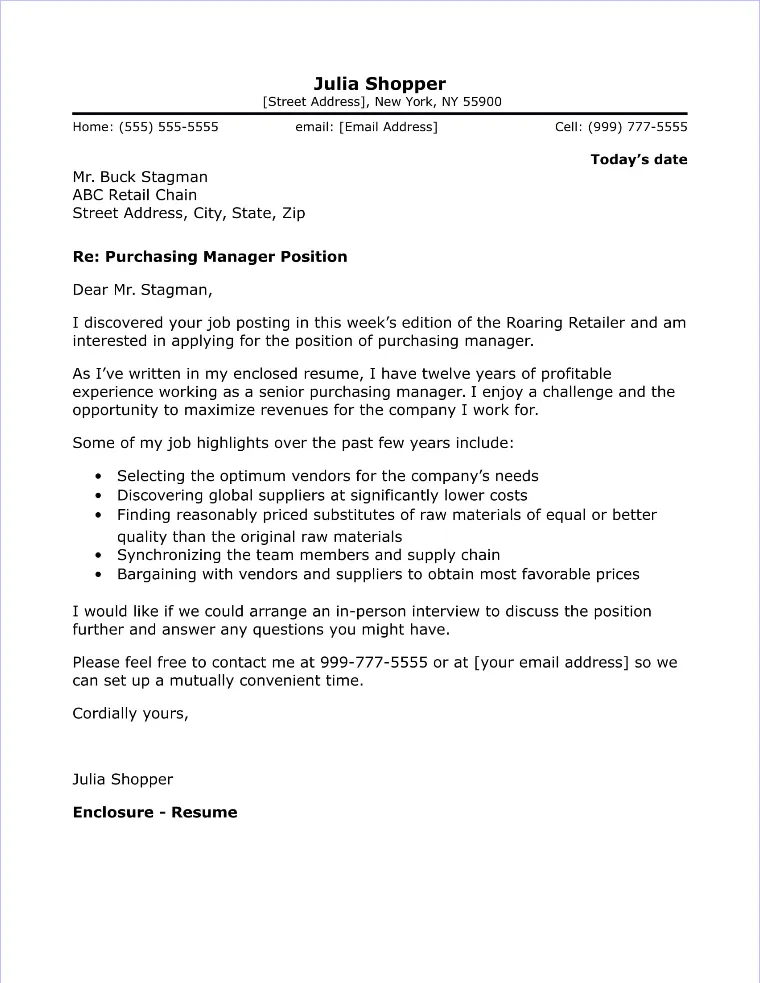Understanding the Purchaser Cover Letter
A purchaser cover letter is a critical document that accompanies your resume when applying for purchasing or procurement positions. It serves as your introduction to the hiring manager, providing an opportunity to highlight your relevant skills, experience, and qualifications in a concise and compelling manner. Unlike your resume, which is a factual record of your employment history, the cover letter allows you to showcase your personality, enthusiasm, and understanding of the specific role and company. A well-crafted cover letter can significantly increase your chances of securing an interview by capturing the employer’s attention and demonstrating your suitability for the position. It should be tailored to each job application, reflecting the requirements outlined in the job description and emphasizing the aspects of your background that align with the employer’s needs. A strong cover letter also conveys your communication skills and attention to detail, both essential qualities for a purchaser.
What Is a Purchaser Cover Letter
The purchaser cover letter is more than just a formality; it’s a strategic tool in your job search arsenal. It’s your chance to make a strong first impression and persuade the hiring manager that you’re the right fit. A successful cover letter doesn’t merely repeat your resume; instead, it expands on key achievements and skills, offering context and demonstrating how your experience aligns with the employer’s requirements. It acts as a narrative, connecting your past experiences with the future role. A cover letter effectively illustrates your understanding of the company’s needs and your ability to contribute to its success. It should be a proactive document that reflects your enthusiasm for the opportunity. It emphasizes your understanding of the procurement process and your ability to secure the best possible value for the organization. Always remember to adapt the content to each specific application, showing your ability to tailor your communication to different audiences.
Key Components of a Purchaser Cover Letter
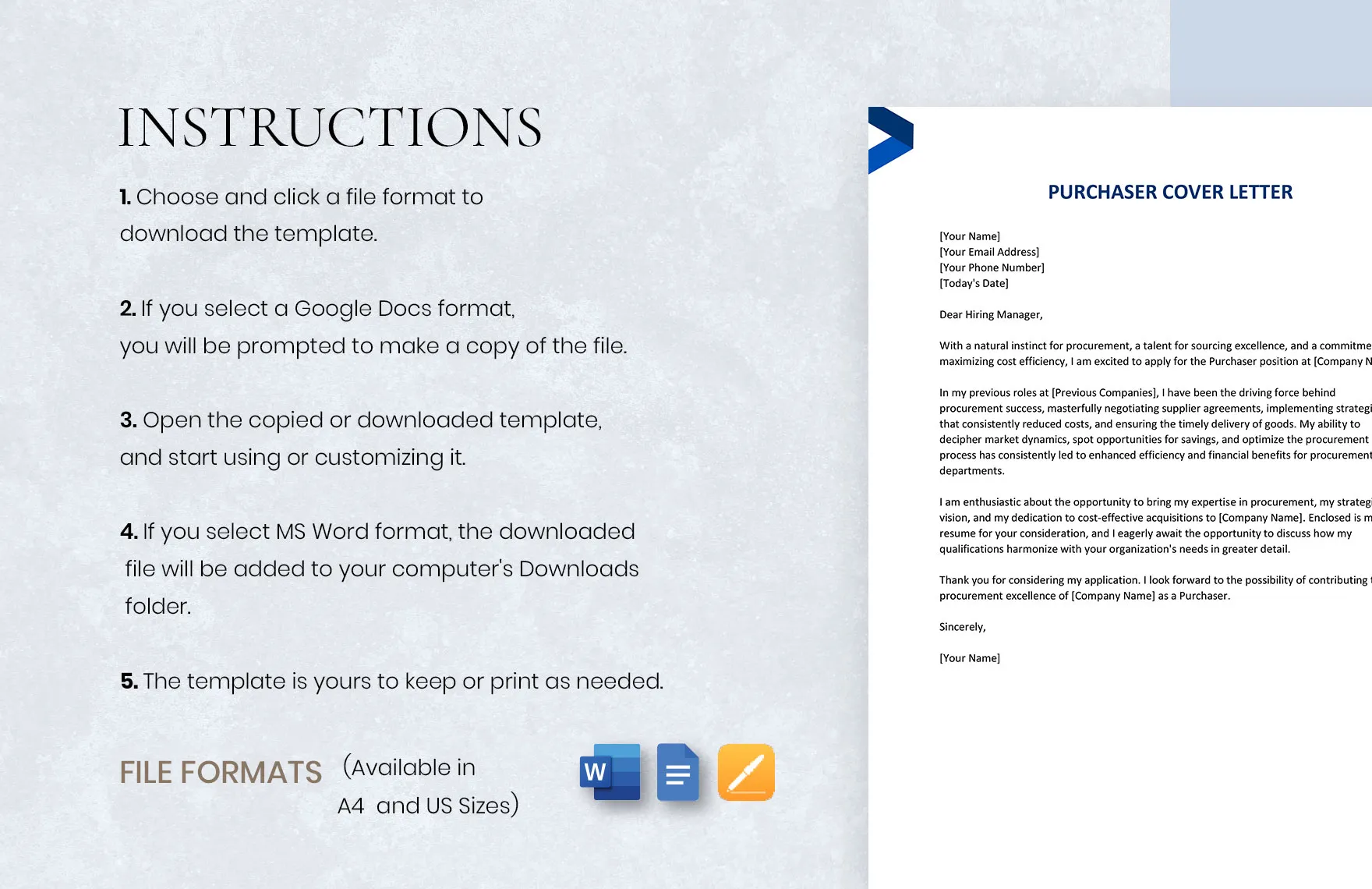
A well-structured purchaser cover letter consists of several essential components, each playing a crucial role in conveying your qualifications and suitability for the role. Begin with a clear and professional contact section, including your name, address, phone number, and email address. Next, address the hiring manager directly, if possible, showing that you’ve done your research. The body of the letter should highlight your most relevant skills and experiences, referencing specific achievements. Quantify your accomplishments whenever possible, using numbers and data to demonstrate the impact of your work. Clearly show your industry knowledge. Also, clearly express your enthusiasm for the position and your understanding of the company’s values and goals. End with a strong closing that reiterates your interest and includes a call to action, such as requesting an interview. This structure will make your letter easy to read and will highlight your key selling points.
Contact Information Essential for Employers
The contact information section of your purchaser cover letter is the first impression and should be clear and professional. Include your full name, address, phone number, and a professional email address. Make sure the email address sounds professional (e.g., firstname.lastname@email.com) and check the address regularly to respond promptly to any communications. Ensuring your contact details are accurate and accessible is essential for the employer to reach you easily. This section is placed at the top of your cover letter, usually left-aligned. By providing all necessary contact details, you make it easier for the hiring manager to reach out to you and move your application forward. This attention to detail also reflects your organizational skills and professionalism, key attributes for a purchaser.
Addressing the Hiring Manager
Addressing the hiring manager by name is a key element in personalizing your cover letter and demonstrating your research and attention to detail. If the hiring manager’s name is listed in the job description, use it. If not, try to find out the name through the company’s website, LinkedIn, or by contacting the HR department. Avoid generic greetings like ‘To Whom It May Concern’. Instead, use ‘Dear Mr./Ms. [Last Name]’. If you are unsure of the gender or preferred title, consider using their full name. Addressing the letter personally shows that you have taken the time to learn about the company and the specific role. This personalized approach immediately captures the hiring manager’s attention and sets you apart from applicants who use generic greetings. This approach demonstrates initiative and respect, reflecting your commitment to the application process.
Highlighting Relevant Skills and Experience
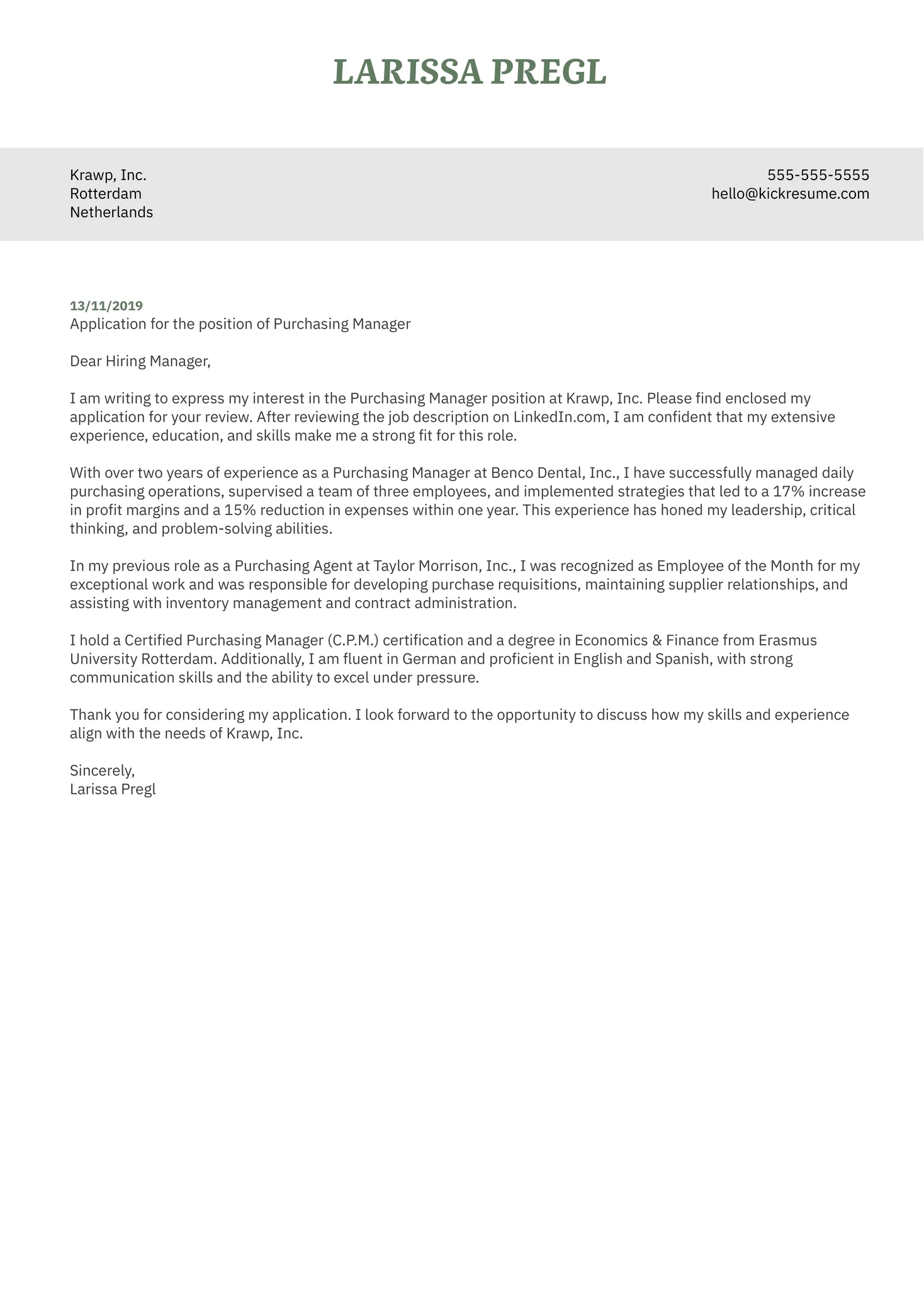
In the body of your purchaser cover letter, focus on highlighting the skills and experiences that are most relevant to the job description. Review the job posting carefully and identify the key requirements and qualifications. Tailor your cover letter to match these needs by providing specific examples of how you have demonstrated these skills in your previous roles. Use action verbs to describe your accomplishments and responsibilities. Examples of skills include negotiation, supplier management, contract management, cost analysis, and inventory management. Show your proficiency in relevant software and procurement systems. Be specific and provide context. Do not simply list your skills; illustrate them with concrete examples that showcase your ability to apply these skills in real-world situations. This approach will resonate with the hiring manager and make your application stand out.
Showcasing Procurement Achievements
Your cover letter is a great place to showcase your procurement achievements. Focus on your successes in previous roles, highlighting how you have added value to your employers. Provide specific examples of cost savings, process improvements, or successful contract negotiations. Quantify your achievements whenever possible, using numbers and data to demonstrate the impact of your work. For example, mention any percentage reductions in purchasing costs, efficiency gains in the supply chain, or successful implementation of new procurement strategies. Show your ability to manage projects effectively. Tailor your examples to the specific requirements of the job you are applying for. This targeted approach will immediately show the hiring manager the value you can bring to their team. Demonstrating your achievements is critical for showing you can make a difference.
Quantifying Accomplishments Use Numbers
Quantifying your accomplishments is one of the most effective ways to make a strong impression in your purchaser cover letter. Instead of making generic statements about your skills, use numbers and data to illustrate the impact of your work. For example, instead of saying ‘I reduced purchasing costs,’ say ‘I reduced purchasing costs by 15% within one year through strategic sourcing and negotiation.’ When you can, state the dollar amount of savings, the percentage of efficiency gains, or the number of successful contracts you managed. Use metrics such as the number of suppliers negotiated with, the value of contracts awarded, and the reduction in lead times. This will help the hiring manager immediately understand the tangible results you have achieved. Numbers provide concrete evidence of your skills and achievements, demonstrating your ability to contribute to the company’s bottom line.
Demonstrating Industry Knowledge
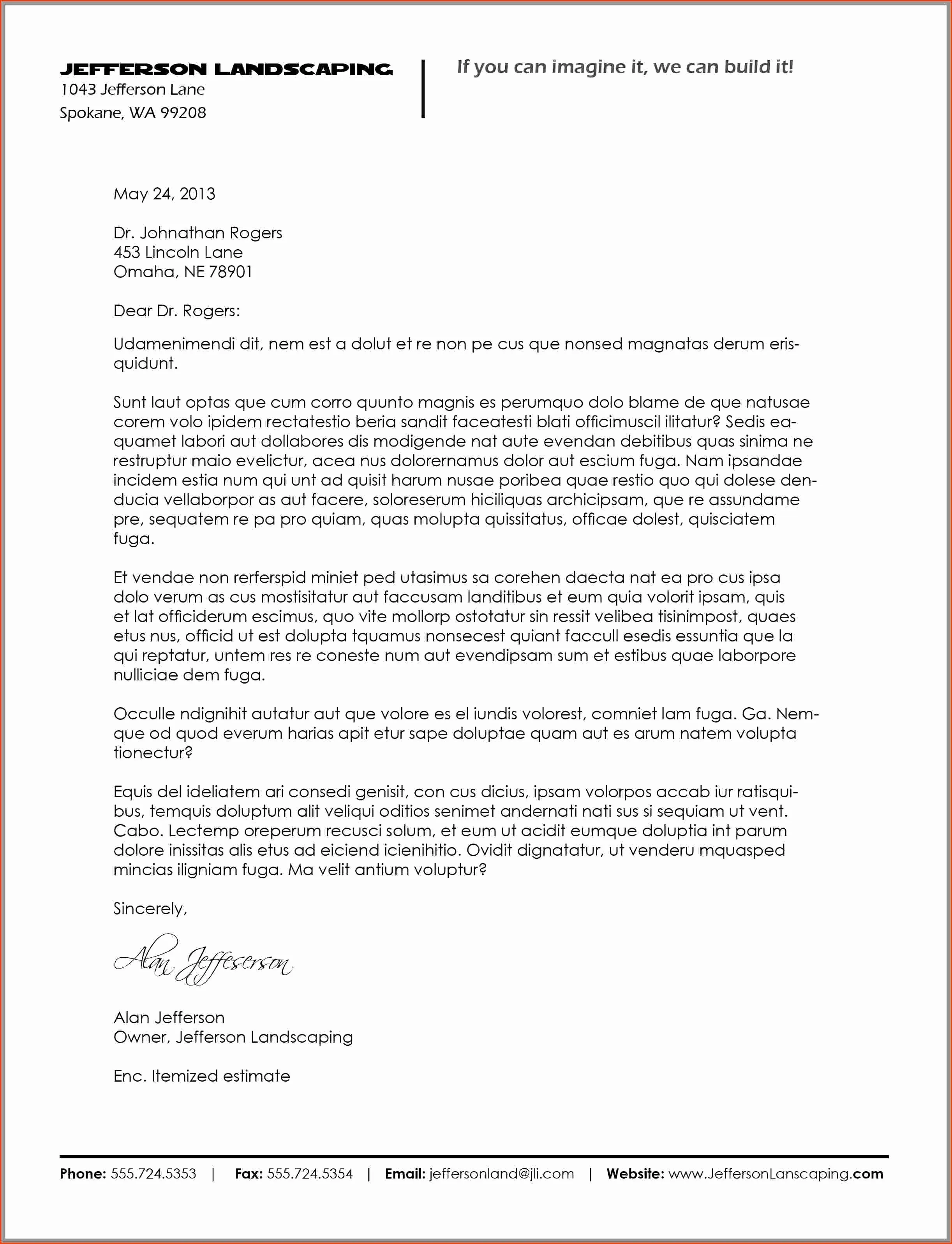
Demonstrating your industry knowledge in your purchaser cover letter is a great way to show that you are familiar with the procurement landscape. Mention any certifications or professional development courses you have completed, such as Certified Professional Purchaser (CPP) or Certified Purchasing Manager (CPM). Show that you understand industry best practices, such as strategic sourcing, risk management, and sustainable procurement. Mention any knowledge of relevant regulations and standards, such as those related to supply chain security. Show that you stay current with industry trends. This information demonstrates your commitment to the profession and your ability to stay abreast of changes. Your industry knowledge will set you apart from other candidates and highlight your suitability for the position.
Expressing Enthusiasm for the Role
Expressing your enthusiasm for the role and the company is crucial for making a positive impression. In your cover letter, show that you have researched the company. Explain what specifically interests you about the position and why you want to work there. Tailor your cover letter to reflect your genuine interest and passion for the role. Mention the company’s values, mission, and recent achievements that resonate with you. Show how your career goals align with the company’s objectives. Do not simply state that you want the job; explain why you are excited about the opportunity to contribute to the company’s success. Your enthusiasm should be genuine and specific, demonstrating your understanding of the role and your desire to make a meaningful contribution. A positive attitude can distinguish you from other applicants.
Emphasizing Company Alignment
Emphasizing company alignment is about showing the hiring manager that you are a good fit for the company culture and values. Research the company’s mission statement, values, and recent news to understand its goals and priorities. Show how your skills, experience, and personal values align with the company’s culture. Use specific examples to illustrate how your past experiences align with the company’s goals. Mention any company-specific initiatives or projects that you admire. Explain how you believe you can contribute to the company’s success based on your understanding of its values. Tailor your cover letter to demonstrate that you share the company’s vision. This will increase your chances of making a positive impression, and show your genuine interest in being part of the team.
Closing Your Cover Letter Effectively
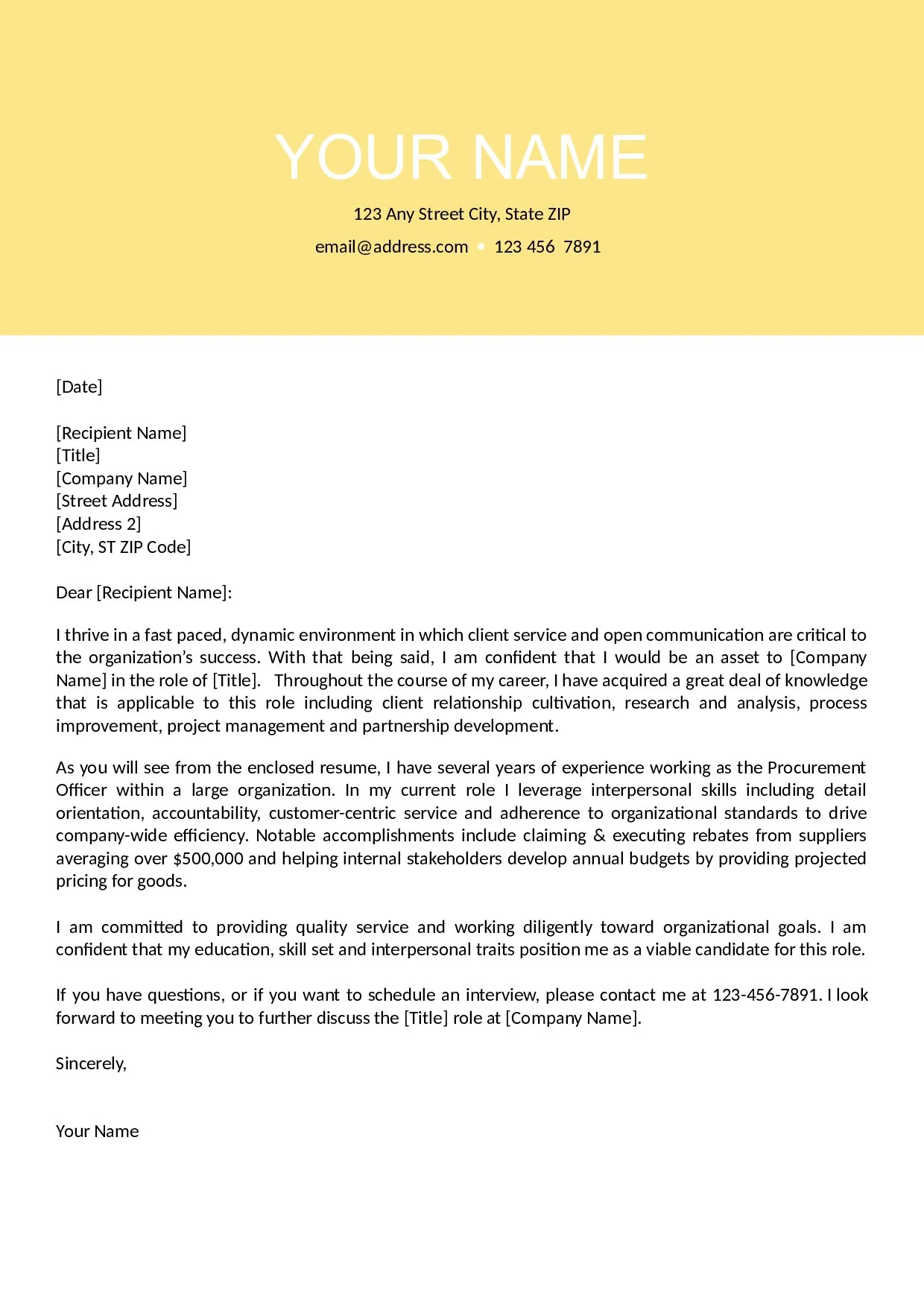
The closing of your purchaser cover letter is your last chance to make a strong impression and encourage the hiring manager to contact you. Reiterate your interest in the position and summarize your key qualifications. Include a call to action, such as requesting an interview or offering to provide further information. Thank the hiring manager for their time and consideration, and use a professional closing, such as ‘Sincerely’ or ‘Best regards’. Make sure to spell out your name clearly. The closing should be concise, professional, and leave the reader with a clear understanding of your interest and qualifications. Do not be afraid to show enthusiasm and confidence in your ability to perform the role. Your closing should reflect your professionalism and your desire to move the application process forward.
Proofreading and Editing Your Cover Letter
Proofreading and editing your cover letter is a critical step in the job application process. Errors in grammar, spelling, and punctuation can make you appear careless and unprofessional. Carefully read your cover letter multiple times, checking for any typos or grammatical errors. Use spell-check and grammar-check tools, but do not rely on them entirely. Ask a friend, family member, or career counselor to review your letter for clarity, accuracy, and style. Ensure that the formatting is consistent and that the layout is easy to read. A well-edited cover letter shows your attention to detail and commitment to quality. Taking the time to proofread and edit your work will make a positive impression on the hiring manager. A polished and error-free cover letter will improve your chances of getting an interview.
Formatting and Design Best Practices
Following formatting and design best practices is important for creating a professional-looking and readable purchaser cover letter. Use a clean and easy-to-read font, such as Arial, Times New Roman, or Calibri, with a font size between 10 and 12 points. Use single-spacing within paragraphs and double-spacing between paragraphs. Ensure that the margins are consistent and that the text is properly aligned (usually left-aligned). Keep your cover letter concise, ideally within one page. Use clear headings and bullet points to break up text and make it easier to scan. A well-formatted cover letter is easy to read. This will improve the reader’s experience and improve your chances of making a positive impression. Your attention to detail will show how you prioritize clarity and professionalism in all communications.
Cover Letter Templates and Examples
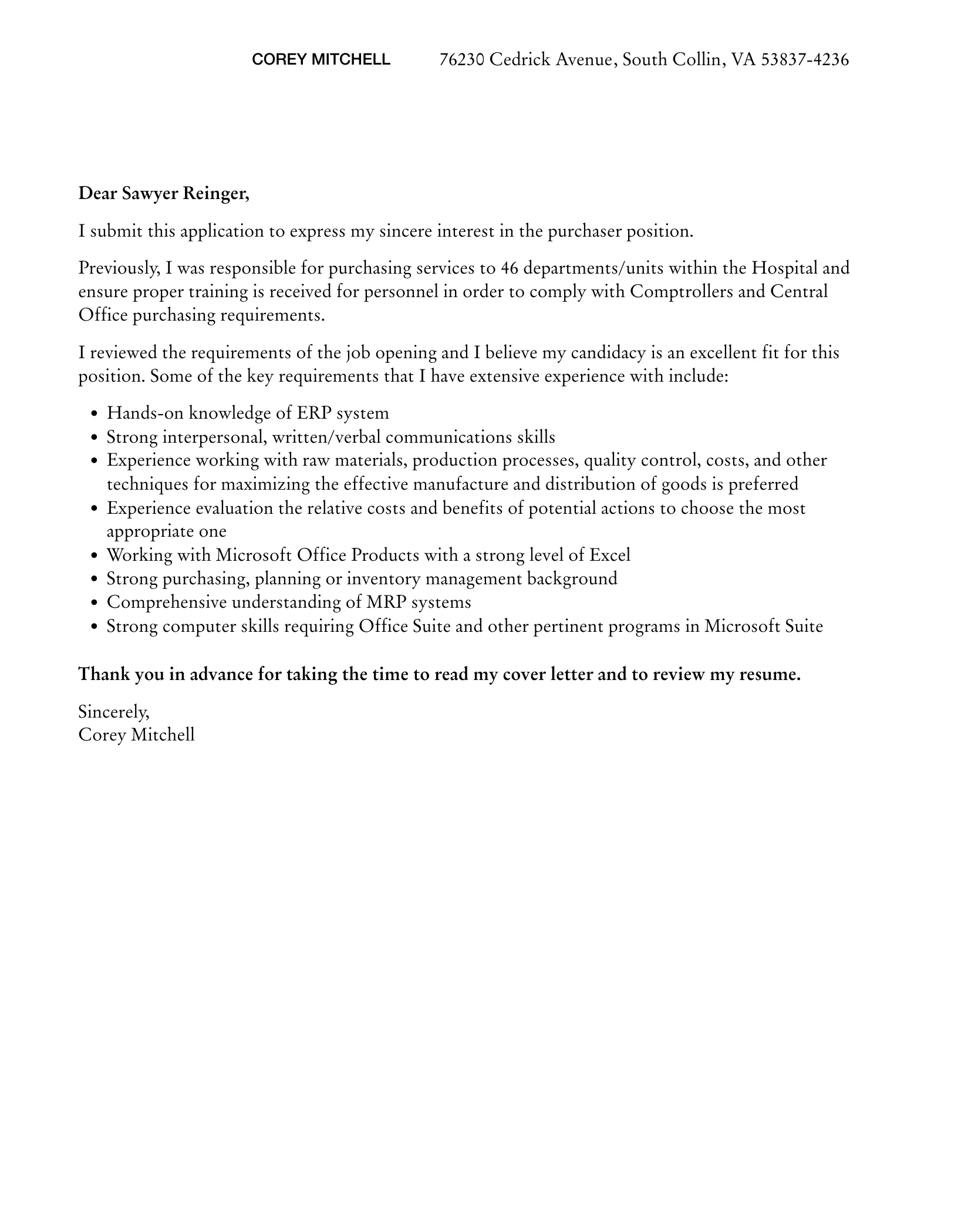
Using cover letter templates and examples can be a great way to get started and ensure you include all the necessary information. You can find templates and examples online or from career services. Use these as a starting point, but make sure to customize them to your specific qualifications and the job description. Do not use a generic template without tailoring it. Replace the placeholder text with your own information and adapt the language to reflect your personal style and the requirements of the job. Make sure to review multiple examples to get a sense of different approaches and writing styles. A well-tailored cover letter, based on a template, can still be very effective. This will help you create a professional and compelling cover letter that highlights your strengths.
Purchaser Cover Letter Sample
Here is a sample purchaser cover letter to serve as a guide (Note this is an example, always personalize and adapt): [Your Name] [Your Address] [Your Phone Number] [Your Email Address] [Date] [Hiring Manager Name] [Hiring Manager Title] [Company Name] [Company Address] Dear [Mr./Ms. Last Name], I am writing to express my strong interest in the Purchaser position at [Company Name], as advertised on [Platform]. With over [Number] years of experience in procurement, I possess a proven track record of successfully managing and optimizing purchasing processes. In my previous role at [Previous Company], I was responsible for [List key responsibilities]. I achieved a [Quantifiable achievement, e.g., 15%] reduction in purchasing costs through strategic sourcing and negotiation. My expertise includes [List key skills, e.g., supplier relationship management, contract negotiation, cost analysis]. I am proficient in [Relevant software and systems]. I am excited about the opportunity to join [Company Name] and contribute to your continued success. Thank you for your time and consideration. I look forward to hearing from you soon. Sincerely, [Your Name].
Customizing the Cover Letter for Each Application
Customizing your cover letter for each application is vital to show that you have reviewed the job description. Research the specific company and its requirements. Identify the key skills and experiences that the employer is looking for. Tailor your cover letter to highlight these qualifications. Avoid using a generic cover letter. Personalize your letter by addressing the hiring manager by name, if possible. Show that you understand the company’s values, mission, and recent activities. Provide specific examples of how your skills and experience align with the job requirements. This targeted approach demonstrates your interest in the role and your understanding of the company’s needs. Customized letters increase the likelihood of your application being noticed, and increase the likelihood of an interview. This attention to detail will show the employer that you’re invested in the opportunity.
Tailoring Your Cover Letter to the Job Description
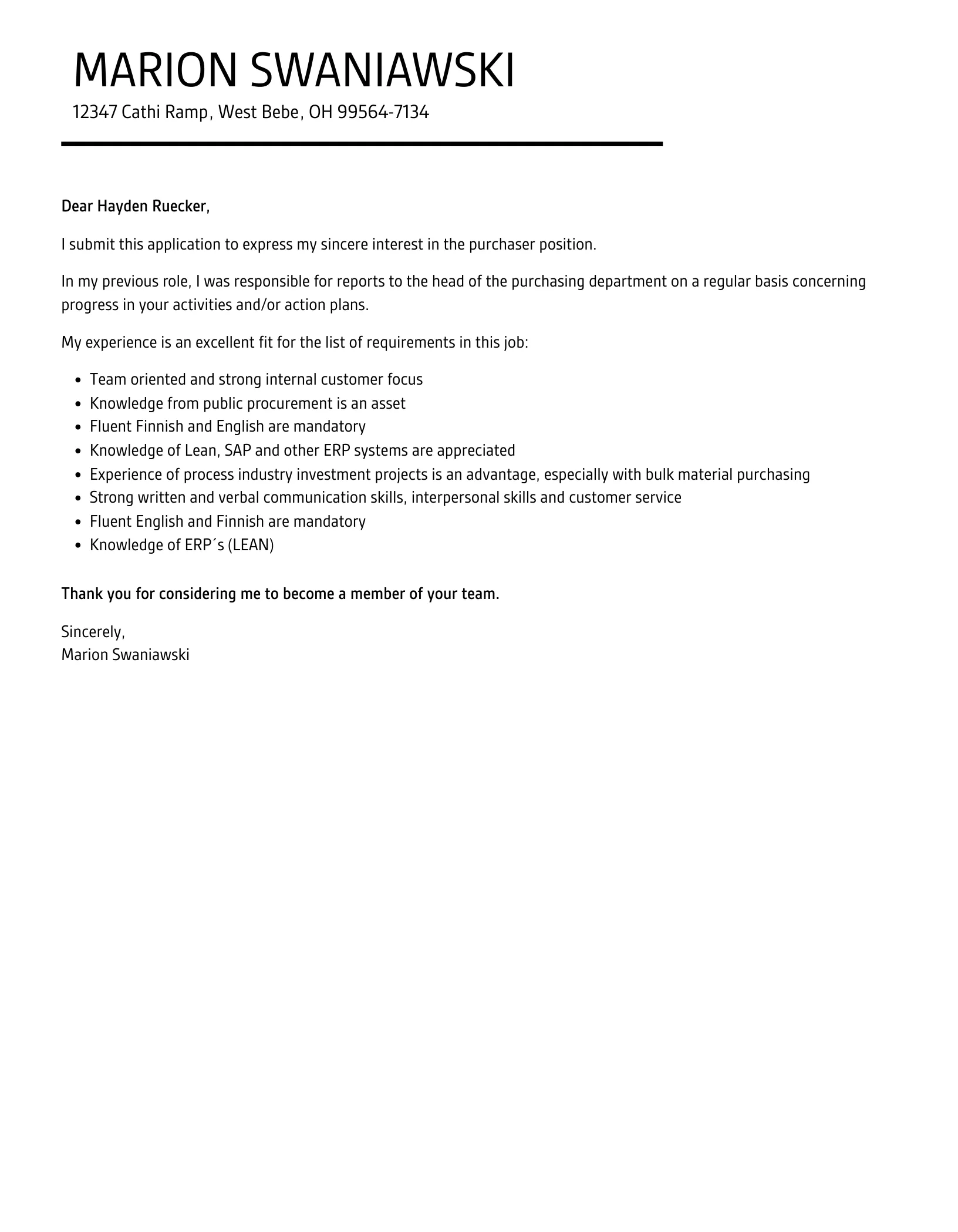
Tailoring your cover letter to the job description is essential for demonstrating your understanding of the specific requirements of the role. Start by carefully reading the job description and identifying the key responsibilities, skills, and qualifications that the employer is seeking. Highlight your relevant experience and skills by providing specific examples. Show how your past accomplishments relate to the requirements. Do not simply repeat the job description. Instead, frame your experiences in a way that demonstrates your ability to meet the employer’s needs. Use the same keywords and phrases from the job description to show that you understand what the employer is looking for. This approach allows you to tailor your cover letter to each application, and increase your chances of securing an interview.
Following Up on Your Application
Following up on your job application is a good practice for demonstrating your continued interest. Send a polite email or make a phone call to the hiring manager or HR department. Be sure to follow up within a reasonable timeframe, usually one to two weeks after submitting your application. Briefly reiterate your interest in the position. Reiterate your qualifications and express your eagerness to learn about the status of your application. Maintain a professional and courteous tone. Be respectful of the hiring manager’s time. The follow-up will demonstrate your continued interest in the position. This can help you remain top-of-mind. It shows your commitment to the opportunity. While a follow-up is optional, it does show extra interest in the position and can make a difference.
